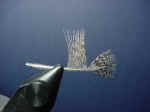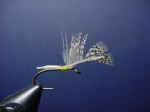|
Fly of the Month Bob Ireton brings together his experience in fly fishing, aquatic entomology, and knowledge of fly tying techniques and materials, to design and tie durable and effective flies. |

|
![]()
Volume 2, Issue 12
December 2001
![]()
PARTRIDGE and YELLOW
Fly and Text by Bob Ireton
Photography by Bob Kimsey and Bob Ireton
Soft-Hackle flies are some of the earliest flies known. Fished 'wet', they resemble rising caddis pupae, and since most streams support a good population of caddis, this fly can be very productive! By adding floatant and fishing 'dry', soft-hackles resemble crippled or drowned mayflies, or a number of other trout foods.
Most soft-hackle flies are tied with too much hackle. The sparser they are, the better they fish. Of all the types of feathers I have tried for soft-hackle flies, I prefer partridge for its remarkably lifelike appearance. Tie with a green body, and you have a ' Partridge and Green' soft hackle, etc. You can substitute different materials, but keep the fly tied sparsely, and use partridge for the hackle.
When fished 'wet', soft-hackles perform best fished on the swing, slowly down and across in the current, in water that is slightly riffled. Add some floatant, and fish them on the surface dead drift. The amount of time that an insect is emerging is very brief, but it is a time when they are very vulnerable. An insect trapped in the surface film is 'fish fast-food', and an easy meal for a hungry trout!
As fly fishermen discover how productive soft-hackles can
be, don't be surprised if they start showing up in more fly boxes!
MATERIALS
Hook - TMC 3769, Daiichi 1530, Dai-Riki 070, Orvis
1641, Mustad 3906
Size 10-16
Thread - Yellow 6/0 for size 12 and larger, 8/0 for size 14 and smaller
Hackle - Gray Partridge
Body - Yellow 6/0 or 8/0 working thread
Thorax - Natural or blended hares mask dubbing
TYING STEPS
| 1 - Choose a
gray partridge feather that is well marked, and has fibers about twice the
length of the hook gape. When removing fibers from the feather shaft, I
suggest doing this with scissors instead of stripping, because when you
strip off fibers from the feather shaft, you will remove a divot from the
shaft, making it weaker, and more prone to break in use.
With this in mind, use your scissors to trim off the fuzzy fibers from the lower end of the shaft. Then cut off the fibers that will touch the hook shank when you wrap the feather so the shiny side faces the eye of the hook. You will need only enough fibers to wrap one complete turn around the hook shaft. Remember that you are trying to imitate only six legs, and two antenna! |
|
| 2 - Place a hook properly in the vice, and bend down barb if desired. Leaving the space of one hook eye, lay on a short thread base. Now hold the prepared soft-hackle feather on the top of the hook with the tip facing forward, and secure the feather with a few wraps. | |
| 3 - Wrap a
body over the shaft of the feather, and using close wraps, continue
rearward.
When you are getting near the barb, cut off the remaining end of the feather shaft, and continue wrapping. Stop at a point above the barb. Now wrap forward using close wraps over the existing thread, to the feather tie in point. Half hitch. |
|
| 4 - Using loose wraps, move the thread rearward to a point 1/4 to 1/3 the length of the hook shank. Dub a short fur thorax forward to the feather tie in location. Half hitch. Then bring thread in front of the hackle. Half hitch. | |
| 5 - Make one complete wrap of hackle around the hook shank. Tie off, and cut off excess feather. Form a head, half hitch, whip finish, and apply head cement. |
![]()
Copyright © 1998 - thisyear The Buckeye United Fly Fishers, Inc. Cincinnati, OH 45242
The Buckeye United Fly Fishers, Inc is a non-profit corporation organized under section 501(c)(3) of the Internal Revenue Code, incorporated in the State of Ohio for the preservation, conservation and wise use of our fishing waters and game fish; and to assist in the protection and improvement of our natural resources




